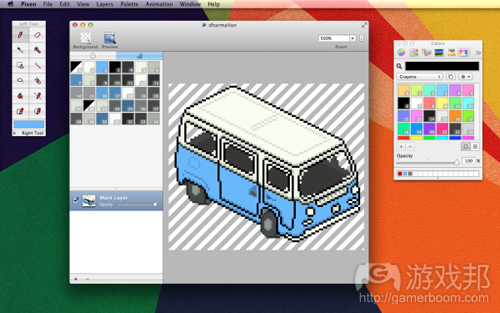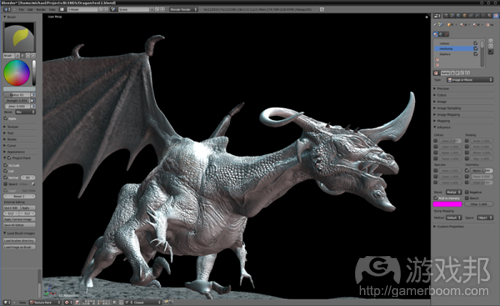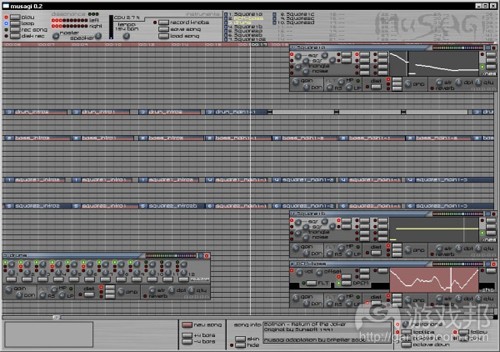16点建议帮助独立开发者决胜Game Jam
作者:Paul Suddaby
Game Jam(独立游戏制作节)现在非常热门。过去只是一个地方性活动现在已经变成全球游戏开发者的盛事。Game Jam流行开来的理由是:它为开发者们提供了实验新想法和展现创意和技术的好机会。为了充分利用参与Game Jam的经历,我整理出下文中的关于技巧、工具和资源的建议,但愿对开发者们有所帮助。
什么是Game Jam?
Game Jam是一种游戏制作活动,参与者要在尽可能短的时间内制作出一款电子游戏。大多数Game Jam活动在周末举行,并持续两天,每个参与者要在48小时内根据一个由举办方投票或选择的秘密主题制作一款游戏。主题作为限定条件,鼓励开发者创意地思考。
往届Game Jam使用的主题非常丰富,比如简单的概念如恐惧、岛屿、黑暗,或者从具体的东西如响尾蛇中提取印象,或者抽象的概念如时间操纵。
有些Game Jam带有竞争性质——这类Game Jam被称作“compo”;其他没有赢家或输家的Game Jam就相当于娱乐活动;有些接受赞助的Game Jam甚至有奖励,根据投票选出各个类别的赢家。无论是什么样的形式,一般认为Game Jam是一个纯粹娱乐的活动。真正的“奖励”就是你制作的游戏。
参加Game Jam的人要么是为了展现自己的才能,要么是为了从完成游戏中获得自豪感,或者磨练技术、从通宵制作原型的疯狂周末中寻找灵感。
尽管有组队活动,有持续更长时间(如一个月)的活动和由许多人在公共场所举办的活动,最普遍的一种Game Jam就是个人参加,为期一个周末,在家完成游戏。
技巧篇
1、吃、睡和实践
这是我要说的第一个技巧,因为毫无疑问是最重要的。当使用48小时法制作游戏时,大部分人的第一个反应是订购许多比萨饼、屯大量饮料,把自己关在房里48小时不出来。这真是糟糕的做法。
做游戏是件脑力活,你不可能连续两天不休息还保持高效。你的休息越充足、饮食越健康,你的工作状态越好。两天高效、头脑清醒地工作24小时,肯定比前10个小时精力满满,后38小时靠咖啡强打精神工作来得有效。
至于实践,不是绝对必须的,我敢说我们这一生中总会有那么两天是无所事事的,不自己练习也不参加game jam之类的活动。然而,当我们遇到一个怎么想也想不出来的时候,没有什么比出去跑跑步或骑自行车更能帮助我们理清头绪的。无论你睡得多好、吃得多好,“闭关修炼”48小时会让脑子一片混乱,难以做好工作。
2、如果有所怀疑,那就选择2D
这条技巧非常简单:如果你很纠结要做2D游戏还是3D游戏,那就选择2D游戏。3D游戏的美术和代码都更加困难,且付出与回报往往不成正比。3D游戏可能更吸引眼球,但也许并不好玩,所以你必须花更多时间修饰基本的功能,这样实验新机制的机会就少了。
3、保持简单
当你在考虑你的游戏设计时,记住,一个运作良好的简单机制比一个运作不好的复杂机制更有意义。多人模式、复杂的AI、过场动画、物理引擎……还是省省吧。
我建议你在设计游戏时想一些能够轻易地在短短的24小时而不是48小时内完成的东西。完成一件事需要的时间往往比你预期的来得多,可能在48小时的最后一分钟你才免强完成。如果因为某些原因你的完成时间提前了,那么你就有更多时间润色你的游戏——这就是优秀的游戏和伟大的游戏之间的区别。
4、着眼于功能,而不是漂亮
你越了解编程,你就越觉得清楚整洁的代码有多重要。你知道if语句块的混乱造成的危险和整齐的继承结构带来的美观和简单。
还是算了吧。
你只有48小时,你要把事情都做完。不要浪费时间去设计冗余少又多功能的类,只要能实现功能就好了。
一周以后再看你的代码,可有很难理解,但你此时你得到了最好的结果,在game jam中这才是最重要的。如果你之后你想继续你的项目,你可以返回去修改。这也是工作,但不是你应该放在宝贵的48小时里做的。
5、动手前有清楚的想法
如果你经验的话,这一点应该是常识。但对于game jam新人来说,这是一个普遍的误区。只有48小时的工作时间,人们往往忍不住立即动手——在刚想到主题时就扑到电脑前开始写代码。
为什么要这样?当你刚刚有一点儿想法时,你还不知道自己在做什么,这时候动手你肯定也想不出来什么。花些时间想清楚你到底要做什么,当你坐在电脑前时头脑中必须有明确的想法,并且能估计到下一步。
6、保证你的游戏容易配置
(保证你的游戏能在这些浏览器上运行)
不是只有你一个人参加game jam;作品会有非常多,玩家有丰富的选择。所以配置才这么重要:面对这么多品质不同的游戏,玩家在任何一款游戏上都不会停留太久。
理想情况下,玩家在点开你的提交页面后就应该能玩你的游戏了。因此,网页游戏显然是最好的选择,但独立可执行文件也是可以的。避免让玩家下载额外的插件,尽可能不要求安装你的游戏。如果玩家发现安装你的游戏需要很长的时间,那么大部分玩家就会跳过它去玩更省麻烦的游戏。根据要求选择相应的平台。
工具篇
1、Bfxr/as3sfxr
Bfxr是一个制作复古风格音效的免费工具。它容易使用,提供大量音效,开发者可以根据自己的需要做选择。as3sfxr是一个简单的sfxr(Bfxr的前身)的ActionScript 3导出工具。它允许开发者使用与Bfxr相同的参数、实时制作音效。当你想随机化通用声音的某个部分时,这个工具非常实用。
2、Ogmo Editor/Tiled Editor/Dame Editor
这是三个容易使用、多功能的免费关卡编辑器,适用于几乎所有类型的项目。与制作自己的关卡编辑器相比,使用这些现成的编辑器会非常节省时间;因为它们可能已经具有你想要的功能。
3、Pixen/GraphicsGale/Aseprite
这三个图形编辑器在制作像素网格的游戏时非常管用。它们都支持sprite表,还有其他许多实用的功能。
我个人最喜欢的是Pixen,因为它很小,界面极其简洁,但不是免费的,且只能在OS系统上运行。GraphicsGale是付费的,且只适用于Windows系统。Aseprite是免费的,且适用于各个系统,如果你像大多数人一样不愿意花钱,那就试试它吧。
4、Blender
当预算为0时,Blender是制作3D图形的最佳选择。它是最简单的3D建模软件之一,一旦你克服了对它的界面的最初困惑后,你就会觉得花钱买它非常值得。但提醒你一下,3D建模很难,即使是使用了像Blender这么强大的工具,这个事实也无法改变。
5、Musagi
Musagi是一个制作芯片音乐的相对简单的工具。与3D建模一样,这里的“相对”才是重点——制作音乐是非常难的,Musagi也不能改变这个事实。但如果你具备了必要技术,使用这个工具制作音乐是非常快的。
资源篇
1、OpenGameArt.org
OpenGameArt.org是免费游戏的美术材料的源泉;从sprite表到3D模型,从音乐到音效,应有尽有;如果你不是追求风格化的人,我强烈推荐这个网站。
2、NoSoapRadio.us/Incompetech.com
这两个是免费音乐的资源网站。No Soap Radio的搜索功能很强大,你可以根据游戏类型或在游戏中播放的位置来寻找你要的音乐。Incompetech是一个比较标准的数据库,但允许你寻找你想要的音乐类型,且它提供的音乐通常品质较高。
这些资源都适用于不太强调音乐的游戏,确实可以提供游戏的品质,毕竟良好的音乐也是游戏体验的支柱之一。
3、FlashKit.com
这个网站有一个庞大的复古风声音和逼真音效的数据库。我个人倾向于使用Bfxr,如果我需要复古音效的话;但当你制作的游戏是走现实路线时,FlashKit就格外实用了。(除非你有一个非常好的录音室来录制警车的声音)
4、CGTextures.com
CGTextures,顾名思义,就是一个为3D模型提供各种高品质纹理的网站。如果要做3D游戏,这个网站可以帮你节约大量时间。只是,这个网站要求注册帐号。
5、Orteil’s Game Idea Generator
如果你做的东西总是千篇一律,你找不到任何灵感,那么你真应该看看这个网站。这个网站通常可以帮助你产生一些原创的想法。当你觉得没有灵感时,就来看看这个网站吧。
总结
以上就是我为准备参加game jam的开发者提出的,关于游戏制作的技巧、工具和资源三个方面的16点建议。好好利用它们,我敢说你会得到一些启发。(本文为游戏邦/gamerboom.com编译,拒绝任何不保留版权的转载,如需转载请联系:游戏邦)
16 Tips, Tools and Resources for Your Next Game Jam
by Paul Suddaby
Game jams have exploded in popularity. What used to be mostly small locally hosted events are now massive worldwide gatherings of game developers. There’s a good reason for this: game jams are a great way for developers to experiment with new ideas and to flex their creative and technical muscles. To make the most out of your game jamming experience, I’ve compiled a list of tips, tools and resources that should help things go smoothly.
Related Posts For more advice on making games (and making them quickly), check out:
Tips for a One-Man Gamedev Team: What to Do Before Even Touching a Computer
How to Get the Most Out of a Game Jam
#1GAM: How to Succeed at Making One Game a Month
All of our posts on Making Your First Game
Before We Start, What Is a Game Jam?
A game jam is an event where participants try to make a video game as quickly as possible. Most game jams take place over a single weekend, where everyone has 48 hours to try to make a game often based on a secret theme that is either voted upon or chosen by the organizers. The theme is used as a limitation that encourages creative thinking.
Themes from past game jams have included everything from simple concepts such as fear, islands, and darkness, to abstract expressions like ouroboros, build the level you play, and time manipulation.
Some jams have a competitive element — this type of jam is referred to as a “compo” — while others have no winners or losers and are simply a fun thing to do. Some sponsored events even have prizes, and many feature voting on games to declare a winner in various categories, but the general consensus is that game jamming is primarily done purely for the fun of it. The real “prize” is your finished game.
Look at all the happy coders. (Image by menno.deen)
People who take part in many game jams do so more for bragging rights, the pride in completing a game, or in the pleasure of honing their craft and seeking inspiration in one crazy weekend of late nights and rapid prototyping.
Though there are team events, jams that last for extended periods of time (such as an entire month), and jams that are held in public places by large numbers of people, the most common type of game jam is one that is performed solo, at home, over a single weekend.
Tips
1. Eat, Sleep and Exercise
Give the energy drinks a miss. (Photo by Austin Kirk)
This is the first tip on this list because it’s without a doubt the most important. When approached with a forty-eight hour deadline to make a game, most people’s initial reaction is to want to order a couple pizzas, stack up on energy drinks, and lock themselves into a room for the entire duration. This is a bad idea.
Making games is cerebral work and you simply can’t do it effectively for two days without interruption. The more rested you are and well fed you are the better you’ll work. Twenty-four hours of effective clear-headed work over two days will get you much farther than an initial ten hours of solid work followed by thirty-eight hours of exhausted caffeine-driven work.
As for exercise, it isn’t absolutely necessary; I’m sure we’ve all spent two days at some point in our life without exercising, game jam or not. However, when you’re tackling a difficult issue that you just can’t seem to figure out, few things are more helpful than going for a run or bike ride to clear your head. No matter how well rested and fed you are, being cooped up for forty-eight hours can lead to a muddled head space that makes it hard to do good work.
2. When in Doubt, Go 2D
Which one looks more complicated?
This tip is a simple one: if you’re debating whether or not to make a 2D game or a 3D game, make a 2D game. Working in three dimensions adds an extra level of complexity to art and coding, and the payoff is almost never worth it. You may stand out more with a fully 3D game, but it probably won’t play as well, and you’ll probably have to spend more time working on basic functionality and much less experimenting with fun new mechanics.
3. Keep Things Simple
When you’re thinking up the design of your game, remember that simple mechanics that work well are infinitely better than complex one’s that don’t. Don’t plan for multiplayer, complex A.I, cut-scenes or a physics engine.
In fact, when designing your game, I recommend trying to come up with something you think you could easily complete in only twenty-four hours, rather than the full forty-eight. Things almost always take longer than you anticipate, and there’s a good chance you’ll only barely finish by the end of the forty-eight hours. If for some reason you get things done faster than you now have that much more time to polish your game, and polish is what separates the good from the great.
4. Code for Functionality, Not a Beautiful Codebase
The more you learn to code the more you come to appreciate the importance of clear, well-structured code. You learn the dangers of massive nested if blocks and the beautiful simplicity that comes with well-executed inheritance structures.
Forget this.
You only have forty-eight hours, and you need to get things done. Don’t waste time setting up versatile classes with minimal redundancy, code for functionality instead.
It might be difficult to understand your code when you look at it a week later, but you’ll get the best results in the moment, and in a game jam that’s what counts. If you want to continue your project afterwards, you can fix things retroactively. It’s a bit of work, but it’s work you shouldn’t be spending your forty-eight hours doing.
5. Have an Idea of What You’re Doing Before You Hit the Computer
This might be common sense to the more experienced of you out there, but this is a huge pitfall that snares many a game jam newbie. With only forty-eight hours to do something, people are inclined to get to work immediately. This often means jumping on the computer as soon as the theme is announced and starting to pound out some code.
Why do this? You don’t know what it is you’re making within a split-second of the theme getting announced and you certainly aren’t going to figure it out as you go. Take some time to decide on exactly what it is you’re going to try to make, have something specific in mind when you first hit the computer, and see what happens from there. For a more in depth look at this topic take a gander at What to Do Before Even Touching a Computer (though keep in mind its suggestions might go a little overboard in the context of a game jam).
6. Make Sure Your Game Is Easily Distributable
Make sure your game runs on these. (Opera optional)
You’re not the only one participating in any given game jam; there are going to be a lot of games, and the people playing them will have a lot to choose from. This is where distribution is important: with so many choices of games with such a wide variety in quality, players won’t want to invest a lot of time into setting any specific game up.
Ideally, your game should be playable one click away from your submission page. Obviously browser-based games are the best for this, but a standalone executable can work well too. Avoid requiring your player to download some sort of framework or plugin they aren’t likely to already have, and under no circumstance have your game require an installation. If they see your game takes too long to set up, most people will simply skip over it and have a try at another game that gives them less hassle. Choose your development platform accordingly.
Tools
1. Bfxr/as3sfxr
Bfxr is a nice little free tool for easily making retro-style sound effects. It offers a range of preset sound effect types to choose from and an easy to use interface for tweaking those sounds exactly to your liking. As3sfxr, on the other hand, is a simple ActionScript 3 port of sfxr (the predecessor to Bfxr) that allows you to dynamically create sound effects in real time using the same parameters as Bfxr, whic his very useful when you want to randomize an aspect of a commonly used sound.
Check out the article on Bfxr and its sister programs to get yourself started with the tool.
2. Ogmo Editor/Tiled Editor/Dame Editor
Here are three free and easy to use level editors with versatile exporters that allow them to fit into the workflow of almost any project. Rather than making your own level editor, it can be a huge time saver at first to use one of these to get things started. Who knows, you may even find that they have all the functionality you’re looking for.
We have guides to both Ogmo and Tiled on this site, so I encourage you to check them out.
3. Pixen/GraphicsGale/Aseprite
These three graphics editors are incredibly useful when making games using pixel art. They all have support for sprite sheets as well as a host of other useful features to discover.
My personal favorite here is Pixen due to its tiny size and extremely clean interface, but it isn’t free and only works on OS X; GraphicsGale also costs money and is Windows-only. Asesprite works on everything under the sun and is free, so give it a look if you, like most people, don’t like spending money.
4. Blender
Blender is the quintessential tool for making 3D graphics on a budget of zero dollars. It’s one of the easiest to use 3D modelling programs out there, once you get over the initial confusion you’ll have with the interface, and it’s surprisingly robust for its price tag. Be warned, though, 3D modelling is very difficult and even as elegant a program as Blender can’t change that.
5. Musagi
From the same mind behind sfxr we have musagi, a relatively simple tool for making your own chiptune music. Just like with 3D modelling, the term “relatively” is important here. Making music can be difficult and musagi can’t change this, but if you have the necessary skills it can be a great outlet for making music very quickly.
Resources
1. OpenGameArt.org
Open Game Art is a great resource for free video game art (go figure). With everything from sprite sheets to 3D models all the way to music and sound effects, this site is an invaluable resource if you’re not of the artistic inclination. I highly recommend you take a look.
2. NoSoapRadio.us/Incompetech.com
These are two useful resources with free music for use in your game. No Soap Radio is particular in its search features, which allows you to sort music based on attributes like the type of game you are making and where the music will be playing in your game. Incompetech is a much more standard database, but provided you are capable of finding the type of track you are looking for, the music is generally of much higher quality.
Both of these resources are useful for those less musically-inclined and can really step up the quality of a game, as good audio is one of the pillars of the gaming experience.
3. FlashKit.com
This website has a huge repository of both retro-style sounds and more realistic foley for use in your game. I personally prefer using Bfxr if I’m going for retro sound effects, but FlashKit is invaluable when trying to go with a more realistic style. (Unless of course you have a great mic and a sound-proof room to record a police siren in.)
4. CGTextures.com
CGTextures is exactly what it sounds like: a site filled to the brim with texture for use on various 3D models. Most of the textures are free, and they are of very high quality. If you are going the 3D route, this site can be a massive time saver, though you do need an account to use the site.
5. Orteil’s Game Idea Generator
If you’re really in a rut and can’t find any ideas for what you want to make you might want to take a look at this site. Though hit or miss, this site can often generate some cool game ideas that can be both original and hilarious. Take a look when all else fails.
Conclusion
So those were my 16 tips, tools and resources for succeeding in your next game jam. Make good use of them and I guarantee you’ll see some good things come from your future game jams. If you want to read more on the subject check out our other article: How to Get the Most Out of a Game Jam.(source:gamedev.tutsplus)





























.png)


















 闽公网安备35020302001549号
闽公网安备35020302001549号